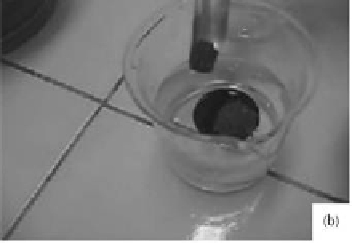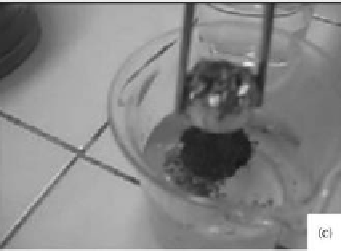Biomedical Engineering Reference
In-Depth Information
oil removal Capability of Composites
The oil removal tests were performed according to the analytical procedure estab-
lished in our laboratory (Lopes et al., 2010; Souza Jr. et al., 2010b). In spite of different
magnetic forces, all the composites were used in the cleanup processes. These tests
were performed according to Figure 19. The first one shows the oil spilling, Figure
19(a). The second one shows the deposition of the nanocomposite on the oil, Figure
19(b). The third picture shows the magnet, Figure 19(c), and the fourth shows the re-
moval of the petroleum, Figure 19(d).
Table 5
shows the oil amount removed by each one of the obtained nanocompos-
ites. It is possible to notice that the increase of the oil mount on the water produces a
larger amount of oil removed from the medium. Therefore, from this table, it is pos-
sible to infer that, in the best case, the 1 g of the composite is able to remove (18.03 ±
0.80) g of the petroleum from the water.
Figure 19.
Oil removal testing (a) spilling oil on the water, (b) adding magnetic nanocomposite, (c)
approaching the magneto, and (d) removing oil from the water.
table 5.
Oil removal capability with different petroleum amounts.
Composite
Removed mass using one gram of the resin (g/g)
Petroleum (8)
Petroleum (12)
Petroleum (16)
RAM1
9.3 ± 0.4
12.7 ± 0.1
16.9 ± 0.4
RAM2
8.6 ± 0.2
12.5 ± 0.2
16.7 ± 0.8
RAM3
9.0 ± 0.3
12.8 ± 0.0
17.0 ± 0.3














Search WWH ::

Custom Search